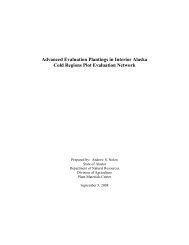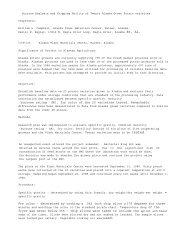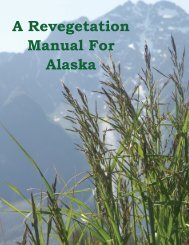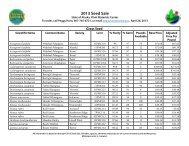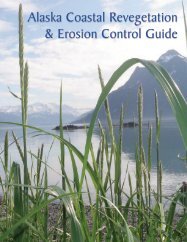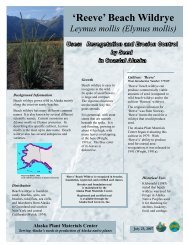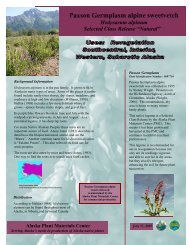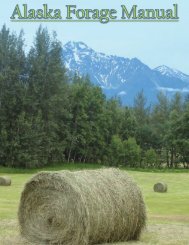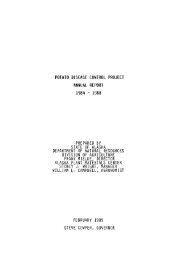Alaska Forage Manual - Alaska Plant Materials Center - State of ...
Alaska Forage Manual - Alaska Plant Materials Center - State of ...
Alaska Forage Manual - Alaska Plant Materials Center - State of ...
You also want an ePaper? Increase the reach of your titles
YUMPU automatically turns print PDFs into web optimized ePapers that Google loves.
Photo: Henrik Reinholdson (Wikimedia.org)<br />
COMMON OAT (Cereal)<br />
Uses<br />
Livestock: Oats are commonly used as a hay and silage<br />
crop, but can also be used for pasture. This small cereal grain<br />
makes excellent forage and is highly palatable to all classes <strong>of</strong><br />
livestock. Early growth oat plants can be fed as “green cut”<br />
forage for livestock. In addition, oat straw makes excellent<br />
roughage.<br />
Wildlife: Oats have excellent forage value for a large variety<br />
<strong>of</strong> wildlife such as bears, elk, bison and moose. They are also<br />
used for food and cover by upland game birds, waterfowl,<br />
small mammals and various song birds.<br />
<strong>Forage</strong> Value<br />
Oats are highly palatable and excellent forage to all classes<br />
<strong>of</strong> livestock and wildlife. The species produces moderate/<br />
high protein and carbohydrate levels. Oats can be fed as hay,<br />
silage, green cut, grain, and/or eaten directly on the pasture.<br />
Nutritional levels will vary depending upon the selected<br />
form that oats are fed as well as how other agronomic inputs<br />
(fertilizer, irrigation, harvest time) are managed and applied.<br />
Oat hay generally contains 10 to 15 % protein and is typically<br />
intercropped with a legume such as peas for added nutrition.<br />
Common Oat, Avena sativa<br />
Common Oat<br />
Avena sativa (L.)<br />
Description<br />
Avena sativa, Common Oat is an erect growing annual bunch<br />
grass that produces a fibrous root system. This small grain<br />
can attain heights greater than 60 centimeters (24 inches),<br />
depending on variety. Oats are generally intercropped with<br />
various legumes such as clovers and/or field peas to increase<br />
forage nutrient levels. This also allows some legumes to use<br />
their tendrils to climb the stalks <strong>of</strong> standing grass. Leaves are<br />
non-auriculate and medium to dark green in color. Avena<br />
sativa produces a large, lance shaped seed with high seedling<br />
vigor. Oat plants typically produce 20,000 seeds per pound <strong>of</strong><br />
seed, depending upon the variety.<br />
Distribution and Adaptation<br />
Oats can be found growing throughout much <strong>of</strong> the world<br />
including <strong>Alaska</strong>, Canada, and the contiguous United <strong>State</strong>s.<br />
It is adapted to fine to coarse textured soils, and prefers a<br />
soil pH between 5.3 - 8.5. Oats are moderately tolerant <strong>of</strong><br />
saline soils and droughty conditions. However, this small grain<br />
prefers adequate moisture and will not tolerate shady growing<br />
environments.<br />
Culture<br />
Oats are best adapted to cool moist climates and should be<br />
planted 1½ to 2 inches deep. A firm seed bed allowing good<br />
seed to soil contact is essential. Soil samples should be collected<br />
and analyzed before seeding. Oats are generally drill seeded at<br />
a rate <strong>of</strong> 50 to 90 lbs/acre. Seeded with a legume, seeding rates<br />
should be reduced by about half, and growth cycles should be<br />
synchronized. Appropriate fertilizer ratios depend upon soil<br />
type, chemistry, and location. Irrigation in combination with<br />
fertilization should increase field productivity.<br />
67



